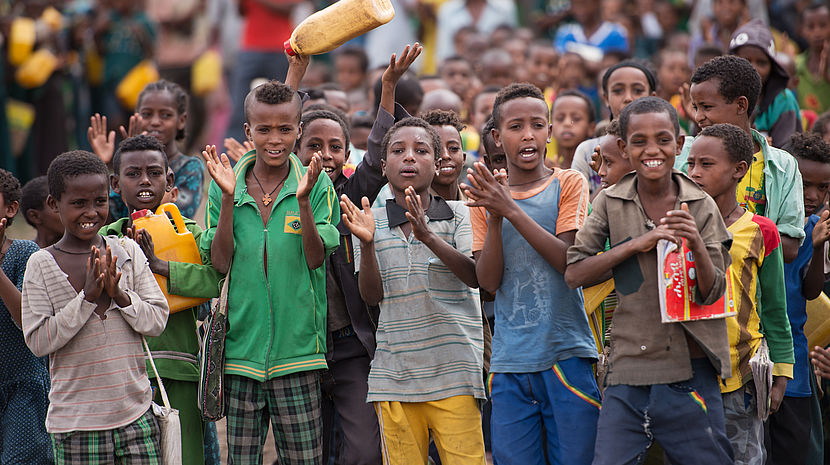22.09.2017 UNGA 72: Focusing on people

The 72nd regular session of the UN General Assembly (UNGA 72) convened at the UN Headquarters in New York on Tuesday, 12 September. In addition, the General Debate opened on Tuesday centering on “Focusing on People: Striving for Peace and a Decent Life for All on a Sustainable Planet.”
The President of the 72nd session of the UNGA, Miroslav Lajčák, identified the following six overarching priorities for his presidency: (1) making a difference in the lives of ordinary people, (2) prevention and mediation in sustaining peace, (3) migration, (4) the SDGs and climate and addressing inequalities, (5) human rights and equality, and (6) quality of mandated events.
Recurrent themes in presentations and at events include the Sustainable Development Goals (SDGs), peace, migration and refugees, climate change, gender equality, education, and youth, most of which are key areas of focus in CBM’s work. As such, I will focus this piece on youth with disabilities and the SDGs as it is increasingly important in today’s world.
Youth with Disabilities and the SDGs
Youth with disabilities and the SDGs are an area of increasing importance since there are approximately 180 to 220 million youth with disabilities worldwide and nearly 80 percent of live in developing countries. [1] Persons with disabilities, including youth with disabilities experience higher rates of unemployment and economic inactivity than their counterparts without disabilities and are at greater risk of insufficient social protection, which is integral to reducing extreme poverty. [2]
The most applicable Goals and targets for youth with disabilities include Goal 4 on education and Goal 8 on employment. Especially, the targets and indicators under Goal 4:
- 4.5 By 2030, eliminate gender disparities in education and ensure equal access to all levels of education and vocational training for the vulnerable, including persons with disabilities, indigenous peoples and children in vulnerable situations
- 4.a Build and upgrade education facilities that are child, disability and gender sensitive and provide safe, non-violent, inclusive and effective learning environments for all
- 4.a.1 Percentage of schools with access to (i) electricity; (ii) Internet for pedagogical purposes; (iii) computers for pedagogical purposes; (iv) adapted infrastructure and materials for students with disabilities; (v) single-sex basic sanitation facilities; (vi) basic handwashing facilities…
And the targets and indicators under Goal 8:
- 8.5 By 2030, achieve full and productive employment and decent work for all women and men, including for young people and persons with disabilities, and equal pay for work of equal value
- 8.5.1 Average hourly earnings of female and male employees by occupation, by age group and persons with disabilities
- 8.5.2 Unemployment rate, by sex, age group and persons with disabilities
There are solid examples this year of regional engagement of youth with disabilities in sustainable development and human rights, including:
- Youth with disabilities participated in the International Disability Alliance and International Disability and Development Consortium regional workshop on the Convention on the Rights of Persons with Disabilities (CRPD) and SDGs in Panama.
- The Youth Commission of the Uruguayan Association of the Deaf (JUVESUR) organized the 1st Deaf Youth Convention in South America in Uruguay in which South American Deaf youth participated and focused on the rights of young people and the CRPD with dialogue, cultural exchange and solidarity.
- The Latin American Network of Non-Governmental Organizations of Persons with Disabilities and their Families (RIADIS) held its 6th international conference in Cuba, which had a parallel event on youth with disabilities and formally established a commission on youth with disabilities.
A strong national example of empowerment of youth with disabilities is from Rwanda through the Disability Rights Fund:
- Uwezo Youth Empowerment is a Rwandan local NGO that was established by youth with disabilities to advocate for their inclusion of youth with disabilities in all youthful programs.
- With support from VSO Rwanda, UWEZO implemented a two-year project aimed at employment of job seekers with disabilities through volunteering and/or internships.
- Uwezo facilitated 45 youth with disabilities to have mentorships, transport and communication allowance.
- As of July 2016, 21 youth with disabilities are fully employed.
Suggestions for engagement on the way forward
- Engage and collaborate more with other civil society groups, such as the United Nations Major Group for Children and Youth.
- Participate in and support youth with disabilities to attend the ECOSOC Youth Forum, UN Youth Delegate Programme and additional UN programs
- Create commissions, subgroups and programs focused on youth in our own organizations and alliances.
- Provide platforms for trainings and information exchange for youth with disabilities.
- Participate in the HLPF 2019, which will focus on “empowering people and ensuring inclusiveness and equality.”
[1] Burton Blatt Institute at Syracuse University and UNDESA. From http://www.un.org/esa/socdev/documents/youth/fact-sheets/youth-with-disabilities.pdf.
[2] (2017). ILO. From http://www.ilo.org/global/topics/disability-and-work/WCMS_475650/lang–en/index.htm.